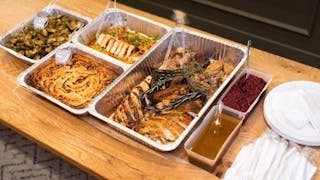Are catered employee meals tax deductible for companies in the U.S.?

Written by Sean Li • October 9, 2025

When companies provide meals to their employees — whether a weekly catered lunch or coffee and snacks in the breakroom — one of the first questions their finance team asks is: “Are these meals tax deductible?”
From the IRS’s perspective, the answer depends entirely on why the meals are provided. Under Section 274 of the Internal Revenue Code, catered employee meals are generally treated as business expenses — but not all business meals are created equal. The rules draw sharp distinctions between meals for employee convenience, business meetings, recreation, and personal benefit.
As of 2025, most company-provided meals are still 50% deductible. But that changes in 2026, when the IRS will phase out many of these deductions altogether under Section 274(o).
Deductibility Rules for Catered Meals
Here’s how the IRS breaks it down today:
50% Deductible Meals (Common in 2025)
Most catered office meals fall under the 50% deduction rule — meaning you can write off half the cost. To qualify:
- The expense must be ordinary and necessary for business operations.
- The meal cannot be lavish or extravagant.
- There must be a clear business purpose — such as a meeting, training, or team work session.
- The company must keep detailed records (who attended, what the business purpose was, and the total cost).
So some examples of what fits the 50% deduction rule includes catered lunches for all-hands meetings, breakfast catering for training sessions, meals provided during long overtime shifts, and snacks in the office kitchen.
100% Deductible Meals (Special Circumstances)
Certain meal categories remain fully deductible:
- Company-wide events: Holiday parties, summer outings, or morale-boosting events for all employees.
- Meals included in wages: If the meal’s value is added to the employee’s taxable compensation.
- De minimis meals: Small, infrequent perks (like an occasional pizza for late-night work).
- Public promotions: Meals or samples given to customers or the public as part of a marketing effort.
"Convenience of the Employer" Test
The “convenience of the employer” test is the IRS rule that decides whether meals given to employees count as a legitimate business expense — not just a perk.
In simple terms the meal has to be mainly for the company’s benefit, not the employee’s comfort or preference.
Here’s how the IRS thinks about it:
- The meal helps the business operate smoothly — for example, keeping employees on-site during short breaks or urgent projects.
- It’s provided for a business reason, like late-night work, safety concerns, or keeping staff available during peak periods.
- It’s not about treating employees or making work more enjoyable — that would be considered a personal benefit, not a business one.
Examples that usually fail this test:
- Free lunch every day just to make employees happy.
- Catering to attract workers back to the office when remote work is possible.
- Meals provided off-site or at employees’ homes.
Catered meals provided on company premises — when they meet the “convenience of the employer” test — can qualify as 100% deductible through 2025.
Grey Areas and Common Food Deductibility Misunderstandings
The gray zone comes down to intent and documentation. Here are a few recurring problem areas we see across CaterCow’s clients:
- Everyday lunches: If employees simply “grab lunch together” without a clear business reason, it’s not deductible.
- Hybrid work setups: Meals delivered to remote employees usually don’t meet the “on business premises” rule.
- Frequent snacks: While de minimis benefits can be fully deductible, large or daily catered spreads likely don’t qualify after 2025.
- Client vs. employee meals: Meals shared with both clients and staff are only 50% deductible, even if part of a larger meeting.
“The IRS draws the line at business purpose. If you can show that the meal supported work — not just convenience — you’re on solid ground.”
— Sean Li, CEO, CaterCow
Records to Maintain for IRS Deductibility
The IRS is clear: no substantiation, no deduction. To protect your deduction in an audit, companies should maintain:
- Invoices or receipts from the caterer.
- Date, location, and purpose of each meal.
- Attendee list (or at least documentation that meals were for employees).
- Categorization (e.g., “training lunch,” “holiday event,” “client meeting”).
Most accounting team will create and maintain seperate internal tagging codes for employee meals (50%), client meals (50%), snacks and coffee (50%), and events and parties (100%)
Major Changes Coming in 2026
Beginning January 1, 2026, most deductions for employer-provided meals will disappear. That includes:
- On-site catering for convenience or overtime.
- Company cafeteria subsidies.
- Meals provided at or near the workplace.
Still deductible after 2025:
- Traditional business meals with clients (50%).
- Meals for food-service and maritime workers (100%).
- Company-wide events for all employees (100%).
For companies that rely on regular workplace catering, 2025 is the last full year to maximize current tax advantages.
The 2026 changes to the tax code — which eliminate most employer-provided meal deductions — are part of a broader rollback of temporary tax breaks introduced under the 2017 Tax Cuts and Jobs Act (TCJA).
The government wanted to reduce “perk-based” corporate deductions. Lawmakers argued that company-provided meals — especially free office catering, snacks, and cafeterias — had become a tax loophole used by high-income employers in tech and finance to provide untaxed benefits. By removing the deduction, Congress aimed to:
- Limit subsidies for workplace perks that mostly benefit employees rather than business operations.
- Redirect tax savings toward lowering corporate tax rates overall.
- Simplify compliance and reduce IRS gray areas
FAQs: Are Catered Employee Meals Tax Deductible for Companies in the U.S.?
Are catered employee meals tax deductible in 2025?
Generally yes, but typically only 50% deductible if they are ordinary and necessary for business, not lavish, and have a clear business purpose with proper documentation.
What changes in 2026 for employer-provided meals?
Many employer-provided meal deductions are scheduled to be eliminated. Traditional client/business meals remain 50% deductible, while company-wide recreational events (like holiday parties) typically remain 100% deductible.
What is the “convenience of the employer” test?
Meals must be provided primarily to benefit the company’s operations (e.g., keeping staff on-site during peak periods or for safety/on-call needs), not primarily for employee comfort or preference.
Can we prepay in 2025 for 2026 catering to keep the deduction?
No. Deductions generally follow when the meal is provided, not when it’s prepaid. Prepaying for 2026 meals in 2025 does not preserve 2025 deductibility.
Are office snacks and coffee deductible?
In 2025, snacks and beverages provided at the workplace are generally 50% deductible when for a valid business purpose and properly documented.
Are client/business meals deductible?
Yes, typically 50% deductible when business is discussed and you maintain who, when, where, and the business purpose.
Are remote or at-home employee meals deductible?
Usually no. Meals delivered to employees’ homes generally do not meet on-premises or employer-convenience requirements.
What records do we need to keep for catered meals?
Keep invoices/receipts, date and location, business purpose, attendee group, and categorize the expense (e.g., employee meal, client meal, recreational event) to support the deduction.
Are company parties and recreational events fully deductible?
Yes. Company-wide recreational events primarily for rank-and-file employees (e.g., holiday parties, picnics) are generally 100% deductible.
Do DoorDash/Uber Eats credits qualify as deductible employee meals?
Credits given to employees for personal meals typically do not qualify as deductible employer-provided meals and may be treated as taxable fringe benefits to the employee.
Are company cafeteria subsidies deductible?
In 2025, costs can often be 50% deductible when requirements are met. Under the scheduled 2026 rules, most employer-provided on-premises meals (including cafeteria subsidies) are not deductible.
What counts as a de minimis meal benefit?
Small, infrequent meals or snacks that are administratively impractical to account for. These can be fully deductible in limited cases, but frequent or substantial spreads usually do not qualify.


